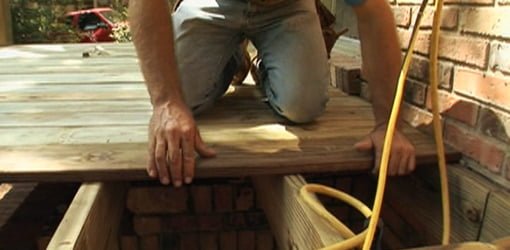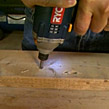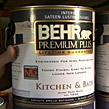Deck Clasped Off House Home Funny

![]()
These homeowners are adding a wood deck and additional outdoor cooking space to an already great backyard so they can further enjoy their outdoors. The backyard wasn't unattractive by any means but it wasn't really appropriate for entertaining nor did it transition well to the existing concrete patio. Building a new 400 sq. ft. wood deck gives the homeowners the perfect place to entertain.
The grilling station was placed conveniently outside the back door leading into the kitchen and because it's covered the homeowners can grill rain or shine. Beneath the deck there's still room to store a lawnmower, wheelbarrow or even bicycles.

On this episode you'll see how to:
- Construct the deck foundation.
- Frame up the floor joists for a deck.
- Install wood decking.
- Construct wood steps for a deck.
- Build handrails for a deck.
- Make custom wood seating for a deck.
- Build a covered grilling area on a deck.
- Install wood lattice around a deck with storage underneath.
The large open deck space gives the kids room to play while still accommodating outdoor furniture. The new deck is certainly attractive, adds value to the home and provides a smooth transition from the house to the concrete patio below. The flagstone walkway between the two makes the backyard even more inviting.

Attaching a deck is such an easy way to change the appearance and add entertaining space to your home, but it does bring up an issue that should be addressed before you add a deck to your home. As you may have noticed, our construction crew attached the deck directly to the house.
Obviously, you have a more structurally sound deck by doing this, but I would recommend attaching a deck to the house only if the home is sheathed in a masonry finish, as this home was with brick. If you have a home sheathed with wood siding, or even vinyl siding, I would not attach the deck directly to the house. In those instances, you have a greater chance of creating water damage.
It's very similar to the way gutters can damage the fascia and soffit areas if they are improperly installed. This doesn't mean if you have a wood home, you can't have a deck. Just be sure to inform your carpenter that you want the deck to be free-standing.
The deck boards can still butt up to the house, so you don't have a gap showing, but there will be no holes drilled into the house to connect the two structures. To be even more picky, I would only attach the deck to a brick home. I think that even stucco can possibly be in danger of water damage if you attach the deck directly to that surface.

Leaving Gaps Between Deck Boards
To gap or not to gap, that is the question. I have listened to many debates over whether or not to leave a gap between the deck boards. In this show, we purposely used leverage to push the deck boards tightly against each other, leaving no gap whatsoever. The key to this issue is the material used to create the deck.
Any time a deck is built from pressure treated lumber, you should NOT have a gap. Here's the reason: Pressure treated lumber is saturated in a liquid chemical when it is constructed. As the material ages, the liquids continue to dissipate. Over the course of a few months to a few years, the wood will shrink.
If you place deck boards down keeping a gap of, let's say 1/4", then over the course of a couple of years or so, the gap will increase. You could see a gap of 1/2" or more before too long. The opposite holds true for composite wood. This material is not going to fluctuate with changing weather conditions, so a slight gap would be appropriate.

Using Nails or Screws on Wood Decks
Speaking of the deck boards, you may have noticed they were attached with nails. Again, we have a debate. Should nails or screws be used? On a personal level, I have always preferred using deck screws. Nails work just fine, but they will be affected by the expansion and contraction of the wood, which means over time, they will be pushed up. It becomes a very minimal maintenance issue to make sure they remain snug to the deck.
But, on the other hand, nails just seem to look better. Don't ask me why, they just do. The other side of the coin is that screws, even though they perform better over the long run, are more expensive. It takes longer to install them, so it becomes a homeowner preference.
Other Tips Seen in This Episode
Simple Solutions with Joe Truini:
Impact Driver vs. Drill Driver

If you need an excuse to buy a new tool, an impact driver is the tool for you. While it looks like a drill driver, an impact driver is made specifically for driving screws. It's perfect for deck building or long lag screws that you could never use with a cordless drill driver. An impact driver has rotation and percussion power which means it hammers and rotates the screws in easily. Of course a cordless impact driver will cost you a bit more than a cordless drill driver, but it has three to four times the power. (Watch This Video)
Best New Products with Danny Lipford:
Behr Kitchen & Bath Enamel

If you're choosing paint for a kitchen or bathroom you'll want one that can hold up to moisture, high traffic or an occasional stain. To do that, Kitchen and Bath Enamel from Behr uses nanoguard technology to protect your walls. The key ingredients in the paint are nano-sized particles that improve the performance of the paint and create a really hard, durable finish that blocks stains so they can easily be wiped off. For about $27 a gallon, it seems like it'll pay for itself.
Around the Yard with Tricia Craven Worley:
Tips for Seeding Grass

To make it easier to see where you've applied grass seed when using a spreader to seed your lawn, add a handful of sawdust to the seed in the spreader to create an easily visible trail in your yard. Make sure the sawdust you used doesn't contain any harmful chemicals, such as sawdust from pressure treated wood, to keep from harming the grass in your lawn. (Watch This Video)
Source: https://todayshomeowner.com/television/612-deck/
0 Response to "Deck Clasped Off House Home Funny"
Post a Comment